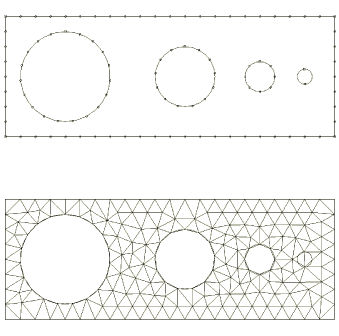
The white dashed lines are guide to the eyes at locations where the cusps are observed before longitudinally slicing them.This book gives Abaqus users who make use of finite-element models in academic or practitioner-based research the in-depth program knowledge that allows them to debug a structural analysis model. To model the isotropic inhomogeneous growth we use the following profile: G = g( x, y, t) I, where the growth rate is given by g( x, y, t) = 1 + f( R) h( d) t, with \(f(R)=\) is large. The swelling and non-swelling zone are fixed throughout the process. (Right): Growth distribution for single cusp formation in asymmetric geometry for FEM simulations. (B) For the cusp formation in 2D FEM simulations, the growth profile along radius, f( R), is assumed in the form of a sigmoid function. (A) Three dimensional model illustration for the FEM simulations. Indentation of polydimethylsiloxane submerged in organic solvents. Young’s modulus, Poisson’s ratio, and Lame’s coefficients of golden delicious apple. Ectopic expression of the PISTILLATA homologous MdPI inhibits fruit tissue growth and changes fruit shape in apple. On the growth and form of cortical convolutions. Higher growth of the apple ( Malus× domestica Borkh.) fruit cortex is supported by resource intensive metabolism during early development. Histological investigations of texture in apples. Gross morphology and histology of developing fruit of the apple. Cell-multiplication and cell-enlargement in the development of the flesh of the apple fruit. The histological structure of the flesh of the apple in relation to growth and senescence. Global gene expression analysis of apple fruit development from the floral bud to ripe fruit. Cell size, cell number, and fruit development. The physiology of growth in apple fruits I. Spatial development of transport structures in apple ( Malus× domestica Borkh.) fruit. Developmental Biology 10th edn (Sinauer Associates, 2013). Catastrophe Theory (Springer Science & Business Media, 2003). Structural Stability and Morphogenesis (Benjamin, 1975).Īrnol’d, V. Singularities: Formation, Structure, and Propagation Vol.


We use simulations to show that the number of cuspidal lobes depends on the ratio of the size of the stalk to the size of the sphere, as well as the amplitude and periodicity of perturbations that mimic the role of fruit anatomy, consistent with observations of multi-cusped fruits.Įggers, J.

These experiments further show that axisymmetric cusps can lose stability and become lobed. Physical experiments using local inhibition in swelling gels corroborate our theoretical predictions. Our observations show that the axisymmetric cusp develops into a self-similar form, which can be understood in terms of a mechanical theory for the inhomogeneous growth of a soft sphere.

Here we study the geometry and morphogenesis of the cusp of an apple by combining observations of fruit growth with a simple theory, finite element simulations and controlled swelling experiments using a physical gel simulacrum. A familiar example of a morphogenetic singularity is seen in the humble apple, which forms in the neighbourhood of the stalk as the apple grows. This universality suggests that they should also naturally arise in biological systems, where active growth, autonomous motion, kinesis and taxis focus deformations in spacetime, as exemplified in the morphogenetic processes determining biological size and shape 4. Singularities are common in diverse physical systems 1 and lead to universal structures 2, 3.


 0 kommentar(er)
0 kommentar(er)
